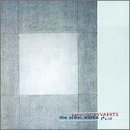| All Artists: Goeyvaerts, Champ D'Action, Antunes Title: Serial Works 1-7 Members Wishing: 0 Total Copies: 0 Label: Megadisc Original Release Date: 1/1/1951 Re-Release Date: 7/25/2000 Genre: Classical Styles: Chamber Music, Historical Periods, Classical (c.1770-1830) Number of Discs: 1 SwapaCD Credits: 1 UPCs: 410965078455, 5413356889123 |
Search - Goeyvaerts, Champ D'Action, Antunes :: Serial Works 1-7
 | Goeyvaerts, Champ D'Action, Antunes Serial Works 1-7 Genre: Classical
|
Larger Image |
CD Details |
CD ReviewsSeminal works from an unjustly neglected postmodernist compo Michael Schell | www.schellsburg.com | 05/16/2010 (5 out of 5 stars) "I'm very glad to have this music available against in an inexpensive downloadable form. Goeyvaerts is perhaps the most important Belgian composer since Franck (with the possible exception of his contemporary Henri Pousseur). The pieces recorded here strongly influenced Stockhausen in the early 1950s as he was formulating his style and aesthetic. In particular, Goeyvaerts' Opus 1 was clearly one of the models for pieces like Kreuzspiel, and his Opus 5 is the inspiration for Stockhausen's earliest electronic music experiments, culminating in Gesang der Jünglinge. Stockhausen went on to become Europe's most famous composer in the 1960s and early 1970s, then suffered a "crash" of sorts becoming a somewhat marginalized figure for the last 30 years of his life. Meanwhile Goeyvaerts remained an obscure, workmanlike figure, known mainly in his home country and to composers and new music enthusiasts elsewhere. Though he never achieved the prestige of Stockhausen and other European contemporaries like Berio, Boulez and Xenakis, or the Americans Cage and Feldman, Goeyvaerts' music is well worth knowing, and in many respects is more approachable than his fellow avant-gardists. These early pieces explore total serialism, pointillism and electronic sounds, and derive from an austere post-Webern aesthetic that cherishes each sound as an integral musical moment. There is a rawness, even sensuality to these pieces that's less apparent with those control freaks Boulez and Stockhausen.
The tape piece Opus 4 "with Dead Tones" takes the tones in a single complex chord and repeats them both together and separately in cycles of lengthening and contracting length and phase. It's an obvious precursor to the "process pieces" of several later composers, including the early masterworks of Steve Reich's early masterpieces (compare Four Organs, written 17 years later in 1970). For me, Opus 4 is the most gripping, beautiful work on the album, rather like watching a solar system from the outside as the orbiting bodies move at varying speeds into and out of alignment. I encourage you to download these pieces and consider for yourself how they stack up against their better known counterparts from the Darmstadt school and elsewhere. I'm enjoying becoming better acquainted with the work of the redoubtable Karol Goeyvaerts." |

 Track Listings (7) - Disc #1
Track Listings (7) - Disc #1